Nvidia RTX 2080 Review
Nvidia RTX 2080 Review
Feast your eyes on ray tracing without spending over a grand on a GPU
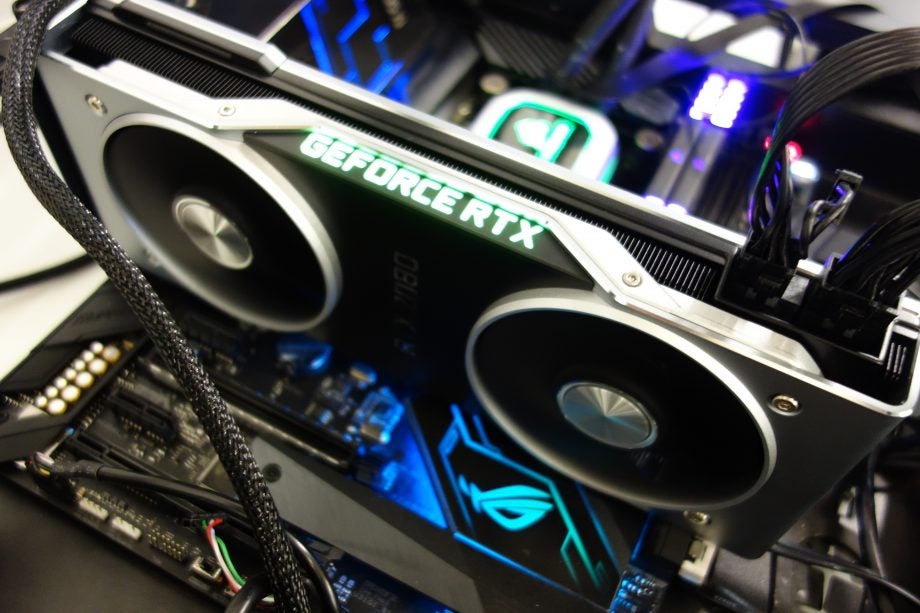
Verdict
The RTX 2080 may offer an almost-identical 4K performance to the cheaper GTX 1080 Ti, but the addition of ray tracing and DLSS could well be enough to make it one of the most lust-worthy graphics cards on the market.
Pros
- Offers ray tracing and DLSS for significantly cheaper price than RTX 2080 Ti
- Capable of running any game in 4K with smooth frame rates
- A sizeable upgrade from the last-gen GTX 1080
Cons
- Offers the same 4K performance as the cheaper GTX 1080 Ti
- Ray tracing and DLSS unavailable at launch
Key Specifications
- Review Price: £749
- New Turing architecture
- 8GB GDDR6
- 2944 CUDA cores
- 1515MHz base clock speed
- 8 Giga Rays/sec
Editor’s Note: The 20-series cards have since been superseded by Nvidia’s new Ampere GPUs. Jump over to our Nvidia RTX 3080 and Nvidia RTX 3070 reviews to find out about the firm’s latest generation cards.
What is the Nvidia GeForce RTX 2080?
The Nvidia RTX 2080 is the middle child in Nvidia’s new 20-Series (otherwise known as Turing) graphics card family. It sits between the beastly RTX 2080 Ti and the more affordable RTX 2070.
It’s also the successor to the GTX 1080, seeing specced-up internals and a boost in performance compared to its Pascal-generation counterpart, which allows for noticeably more stable frame rates when running games in Ultra HD. However, improved frame rates aren’t the only incentive for an upgrade this time round.
Like all the graphics cards in the Turing lineup, the Nvidia RTX 2080 boasts support for real-time ray tracing and Deep Learning Super-Sampling (DLSS).
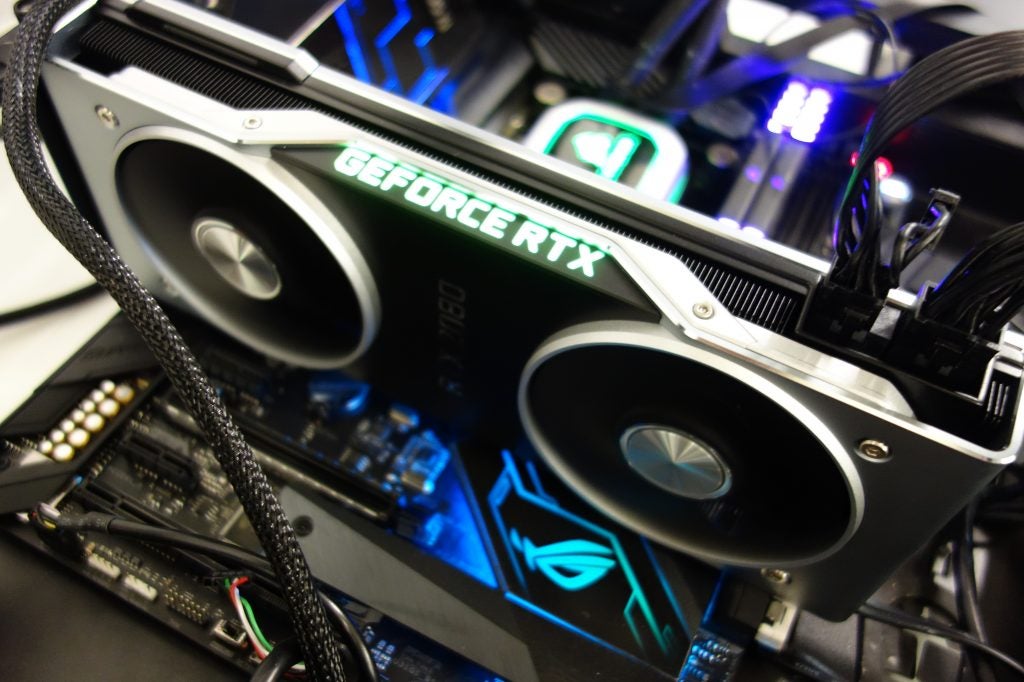
The light-up lettering helps to make the RTX 2080 one of the classiest graphics cards around
While few games really utilise either of these features right now, both ray tracing and DLSS are now supported on Battlefield 5 and Metro Exodus.
Real-time ray tracing will enable video game developers to simulate lighting effects that are more realistic in terms of both appearance and behaviour. This will help to make in-game environments look more convincing than ever before.
Deep Learning Super Sampling, meanwhile, uses artificial intelligence to render video more efficiently, allowing for a smoother all-round performance.
The only issues with the RTX 2080? The cheaper GTX 1080 Ti still competes when it comes to bog-standard performance power.
The news that Nvidia will release a driver in April which will see ray tracing coming to older GTX cards does diminish the appeal of the RTX line-up somewhat, but perhaps crucially, DLSS is something that will be exclusive to 20 Series cards. To find out why that’s crucial, read on.
Related: Best graphics card
Nvidia RTX 2080 – Specs and technology
Like the other two Turing graphics cards, the Nvidia RTX 2080 is home to new hardware never before seen in a GeForce GPU. These include the Turing SM, Tensor Core and RT Core, which have all been implemented to make the likes of ray tracing and DLSS possible.
However, bear in mind that each of Nvidia’s Turing GPUs offer varying degrees of performance for these new features. Nvidia measures this difference via “Giga Rays”. The RTX 2080 Ti produces 10 Giga Rays per second, while the RTX 2080 is capable of eight in the same timeframe.
| Cuda Cores | Standard memory config | Memory bandwidth GB/sec | Base clock speed (MHz) | Boost clock speed (MHz) | Giga Rays/s | |
| RTX 2080 Ti | 4352 | 11GB GDDR6 | 616 | 1350 | 1635 | 10 |
| RTX 2080 | 2944 | 8GB GDDR6 | 448 | 1515 | 1800 | 8 |
| RTX 2070 | 2304 | 8GB GDDR6 | 448 | 1410 | 1710 | 6 |
| GTX 1080 Ti | 3584 | 11GB GDDR5X | 484 | 1480 | 1582 | 1.1 |
| GTX 1080 | 2560 | 8GB GDDR5X | 320 | 1607 | 1733 | 0.877 |
So what does the two-second difference mean in terms of visual quality? Honestly, I don’t know yet; few outside Nvidia do. That’s because we’re yet to see real-time ray tracing in action – the update to enable it won’t be available until later this month. I’ll be sure to update this review once I do test it out, however.
The 20-Series graphics cards have also seen improvements in the architecture. The increase in CUDA cores looks to be the most significant, considering it’s the most important feature for pushing those frame rate figures as high as possible.
The RTX 2080 boasts a 15% increase in CUDA cores over the GTX 1080. Our benchmark results prove that this translates into a sizeable improvement to all-round performance.
On a more sour note, the RTX 2080 actually lags behind the last-gen GTX 1080 Ti for CUDA cores. In fact, there’s a 17.86% difference between the two. Of course, since the GTX 1080 Ti is sporting the older Pascal architecture, that difference in CUDA cores doesn’t necessarily guarantee the GTX 1080 Ti a superior performance.
The RTX 2080 also has 8GB of 14Gbps GDDR6 memory on offer, while boosted clock speeds can reach an impressive 1800MHz when overclocked – although we found overclocked clock speeds to even surpass that figure.
Related: Nvidia RTX 2080 Ti review
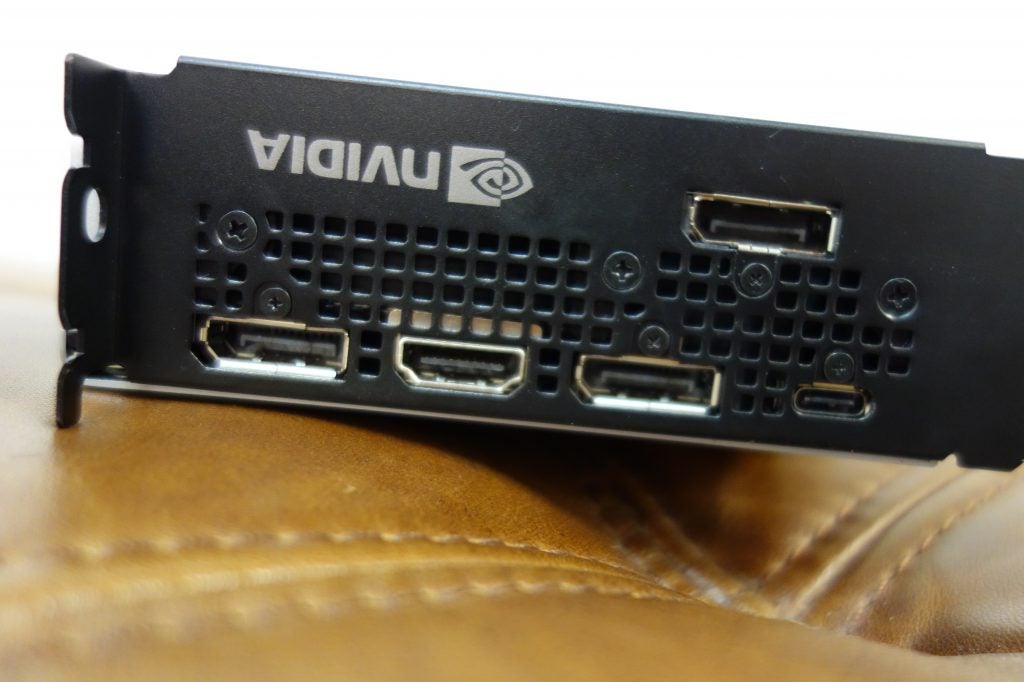
The Nvidia RTX 2080 has all the ports you’d need on a graphics card
Given all of the hardware upgrades, there’s no surprise that the RTX 2080 features a 45-watt increase in power draw compared to the GTX 1080, coming in at 225W. With this in mind, I’d advise you to check that your PSU is up to the test before upgrading.
SLI is supported here, too, while the RTX 2080 features the same ports as the rest of the Turing lineup: HDMI, USB-C and DisplayPort. The latter, in particular, will come in handy for allowing connectivity to the HTC Vive Pro.
Nvidia RTX 2080 – Ray tracing
Judging from the spec sheet, there’s doesn’t appear to be a whole lot separating the RTX 2080 from the GTX 1080 Ti. But there is one key difference that makes the RTX 2080 a significantly more enticing purchase: ray tracing.
Rather than just boosting frame rates, ray tracing introduces a whole new way of simulating light effects. With this new technology, light will reflect and bounce off surfaces as they would in real life. This results in more realistic shadows and gives shiny surfaces a more glossy appearance.

Nvidia’s Star Wars demo showcased how impressive reflective armour can look with ray tracing
Nvidia has shown off a host of demos to display the potential of ray tracing. From reflective Stormtrooper armour to the spot-illuminated tunnels of Metro Exodus, the examples of ray tracing certainly look impressive.
UPDATE: Since my initial review, two titles – Battlefield 5 and Metro Exodus – have emerged as standard bearers for ray tracing and DLSS. Nvidia’s GeForce Game Ready Driver 418.91 update optimises these features on both these games. I’m re-benchmarking these games on all the 20 Series cards reviewed so far, and I’ll update this section with more details once I’ve thoroughly tested everything.
Other games that will feature the revolutionary ray-tracing technology include Shadow of the Tomb Raider and Anthem. The full list of supported titles can be seen below.
- Assetto Corsa Competizione
- Atomic Heart
- Battlefield 5
- Control
- Enlisted
- MechWarrior 5: Mercenaries
- Metro Exodus
- Shadow of the Tomb Raider
- Justice
- JX3
- Project DH
Many more games are expected to add support in 2019, although which titles they’ll be is anyone’s guess.
Related: Shadow of the Tomb Raider review
Nvidia RTX 2080 – Deep Learning Super-Sampling
The second headline-grabbing feature of the Turing lineup is Deep Learning Super-Sampling, or DLSS for short. Its impact on video game visuals is more discreet than ray tracing, but could potentially be just as important.
DLSS uses artificial intelligence to lend a helping hand towards video rendering. This doesn’t necessarily improve the quality of the image compared to more traditional rendering methods, but it does allow the GPU to focus elsewhere, resulting in a more efficient performance overall.

Cool guys don’t look at explosions – Hitman 2 is one of many games to have already confirmed support for DLSS
Sadly, DLSS is also yet to be enabled on the new Turing cards. There’s no word on a potential release date, but I’ll update this review with my impressions as soon as I get to test it out.
On a more positive note, DLSS is apparently significantly easier to implement than ray tracing. This means we’ll likely see a long list of games announcing their support in the next few months. For now, though, a healthy list of 25 games are confirmed to be featuring DLSS.
- Ark: Survival Evolved
- Darksiders 3
- Final Fantasy XV
- Hellblade: Senua’s Sacrifice
- Hitman 2
- Mechwarrior 5: Mercenaries
- Islands of Nyne: Battle Royale
- Overkill’s The Walking Dead
- PlayerUnknown’s Battlegrounds
- SCUM
- Shadow of the Tomb Raider
- Stormdivers
- We Happy Few
Once more games are confirmed to support DLSS, I’ll update this list.
Related: Hitman 2 review
Nvidia RTX 2080 – Performance and benchmarks
Testing methodology
I benchmarked the Nvidia RTX 2080 using Trusted Review’s test rig, which has been built to match the specs of a top end consumer gaming PC. The exact components of the build can be seen below:
- Motherboard: Asus Maximus XI Hero (Wi-Fi)
- Processor: Intel Core i9-9900K (not overclocked)
- RAM: Corsair Vengeance 2666MHz, 16GB DDR4
- Cooler: Corsair Hydro Series H150i PRO RGB 360mm liquid cooler
- PSU: Corsair CX750M
- SSD: Samsung 850 EVO
- OS: Windows 10 Pro 64-bit
This is the same test rig we use for all of our component testing, ensuring that all of our reviews are fair and comparable.
Note that the Nvidia RTX 2080 Ti was originally benchmarked using a Intel Core i7-8700K processor, but ‘ll be updating the review shortly to reflect the new benchmark results using the upgraded i9-9900K CPU.
Related: Intel Core i9-9900K review
Graphics cards for comparison
During the testing process of the RTX 2080, I benchmarked three other graphics cards for comparison. These GPUs were the RTX 2080 Ti, the GTX 1080 Ti and the GTX 1080.
I included the latter two graphics cards since it’s likely that anyone upgrading to the RTX 2080 will already own one of those two GPUs. Meanwhile, I included the RTX 2080 Ti’s scores in my testing to show how much of a difference there is in performance between the two Turing cards.
All of these graphics cards are official Founders Editions built by Nvidia, and should therefore act as a baseline for third-party alternatives.
- Founders Edition Nvidia GeForce RTX 2080 Ti
- Founders Edition Nvidia GeForce GTX 1080 Ti
- Founders Edition Nvidia GeForce GTX 1080
Nvidia RTX 2080 – Benchmarks
Shadow of the Tomb Raider
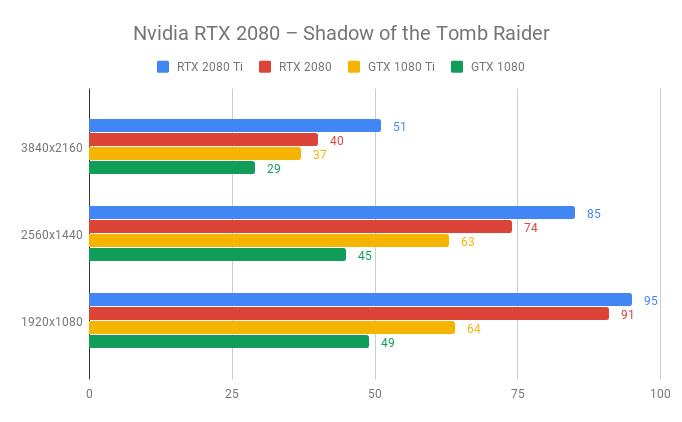
Shadow of the Tomb Raider is one of my go-to games for benchmarking since it’s one of the most technically demanding and visually stunning titles currently available. It’s also one of the few games to feature both ray tracing and DLSS.
The Shadow of the Tomb Raider results show that the RTX 2080 has seen a sizeable performance boost compared to its Pascal counterpart, the GTX 1080. In fact, there’s been a whopping 38% increase in frame rates when set to a 3840 x 2160 (4K) resolution.
The difference only widens when running Shadow of the Tomb Raider at 1920 x 1080 (Full HD), with the RTX 2080 boasting a mighty 86% improvement for frame rates at 91fps. It’s clear that the RTX 2080 offers a substantial boost over its last-gen equivalent.
Results weren’t so impressive when compared to the GTX 1080 Ti. Despite sporting last-generation architecture, the GTX 1080 Ti was only 3fps worse off than the RTX 2080 for the 4K test. There were much more respectable increases in performance at lower resolutions, but if you have the money to splash out on an RTX 2080, then you’re most likely going to be gaming in Ultra HD.
Ghost Recon: Wildlands
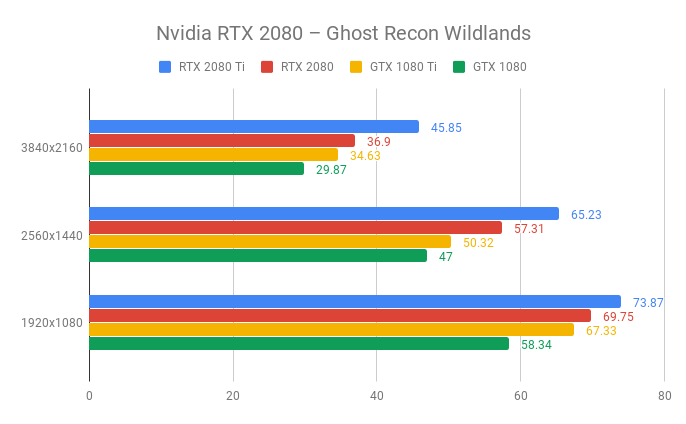
It was a similar story with Ghost Recon: Wildlands. The RTX 2080 boasts a decent frame rate improvement on the GTX 1080, with a 24% boost in the 4K benchmark test and a 20% increase for HD.
However, the 36.90fps at 4K is still some way off the much-desired 60fps for which most gamers aim. The RTX 2080’s performance is also quite far behind what the RTX 2080 Ti offers. Of course, you get what you pay for, with the RTX 2080 Ti costing £350 more than the RTX 2080.
Once again, the RTX 2080 doesn’t offer significantly better frame rates than the GTX 1080 Ti. Ray tracing and DLSS are the only features that really separate the two graphics cards here, and since Ghost Recon: Wildlands doesn’t’ support either, you won’t see any real benefit by upgrading from a GTX 1080 Ti for this title.
Dirt Rally
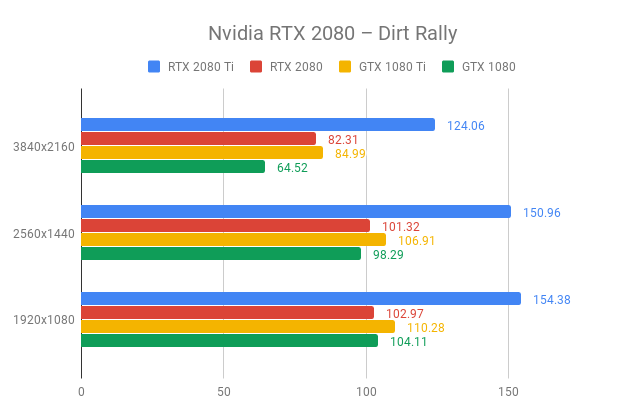
Instead of only benchmarking super-intensive video games, I also tested how the RTX 2080 would perform with titles released a few years ago. Predictably, the GPU posted high frame rates across the board, but something very interesting happened when compared to the GTX 1080 Ti.
The GTX 1080 Ti actually outperformed the RTX 2080 in all three benchmark tests. Admittedly, the difference was marginal, but it’s nevertheless enough to make people hesitate when opting for the RTX 2080 ahead of the GTX 1080.
That said, all of the benchmark results for Dirt Rally from the four graphics cards were so high that to the naked eye, you’d struggle to see any difference.
3DMark
| Fire Strike Ultra | |
| RTX 2080 Ti | 8090 |
| RTX 2080 | 6488 |
| GTX 1080 Ti | 6654 |
| GTX 1080 | 5047 |
As well as using video games to test the RTX 2080, I also ran 3DMark’s Fire Strike Ultra benchmark programme. Instead of giving you an average frame rate figure, it churns out a unique score that’s useful for comparing the overall performance of the GPU.
Interestingly, the GTX 1080 Ti actually bettered the RTX 2080’s result, once again establishing that the only advantage the latter really has is ray tracing and DLSS.
Nvidia RTX 2080 – Performance conclusions
All four benchmark tests prove that you’ll be getting a meaty upgrade if moving from a GTX 1080 to an RTX 2080. If you’re looking to boost those frame rates for 4K gaming, then the RTX 2080 looks to be a worthwhile upgrade.
There’s one major issue, however: the GTX 1080 Ti is available at a lower price and offers an almost identical performance to the RTX 2080 for 4K content, despite featuring older architecture.
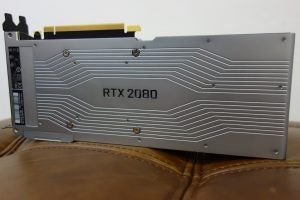
The RTX 2080 looks almost identical to the RTX 2080 Ti, aside from the name scrawled on its back
Since all three 20-Series GPUs are overkill if you intend to just play games in HD, the only reason to buy an RTX 2080 over the GTX 1080 Ti is to get access to the new ray tracing and DLSS features.
If you’re not a gamer, and just want a GPU for animation and design work, then there’s very little point in buying the RTX 2080. For gamers, though, it depends entirely on whether ray tracing and DLSS make enough of an impact to merit the extra cash. I reckon they will, but we need to wait until I can test the two features to know for sure. I’ll be updating this review as soon as I’m able to test out ray tracing and DLSS properly.
Related: Nvidia GTX 1080 Ti review
Nvidia RTX 2080 – Overclocking, heat and power consumption
If you’re upgrading from a GTX 1080, you’ll need to make sure that your PSU is up to scratch. With a peak power consumption of 326.4 watts, the RTX 2080 has seen a hefty wattage increase of 69.9 watts compared to the GTX 1080.
This figure brings it to roughly the same required wattage as the GTX 1080 Ti, which has a peak power consumption of 341.3. So if you’re upgrading from a GTX 1080 Ti, your current setup should be able to handle the RTX 2080 without issue.
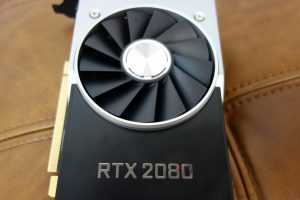
If you want to boost those frame rates, you can overclock the RTX 2080 to an impressive margin
Of course, if you want to overclock the RTX 2080 then you’ll want a quality cooler to prevent your rig from hotting up. With Trusted Reviews’ setup, I was able to squeeze out an extra boost to performance – a 150MHz overclock, to be exact.
I used the Unigine Heaven software throughout the overclocking process, and managed to see a 9fps improvement in the benchmark results. If I tried to crank up the clock speeds any further, Unigine would quickly shut down. That’s nothing to be ashamed of, though, since these overclocking results are still very impressive.
Just like the RTX 2080 Ti, temperatures never surpassed 75°C – despite the software crashes – so I never needed to worry about the RTX 2080 igniting. The dual-fan setup worked incredibly well to keep things cool too. Despite putting the RTX 2080 under so much pressure, it never became noticeably loud. This was impressive, as nobody wants a gaming rig that shounds like a jet.
Why buy the Nvidia RTX 2080?
The best way to think of the RTX 2080 is as the (almost) identical twin of GTX 1080 Ti, but with the added bonus of ray tracing and DLSS.
The problem is, I haven’t yet been able to test ray tracing and DLSS, so this graphics card is tough to recommend right now. I’m pretty optimistic that these upcoming features – particularly ray tracing – will be massive game-changers for video game visuals. Nevertheless, I still suggest waiting until I’ve had the chance to test them for myself.
If ray tracing and DLSS are as incredible as Nvidia claims, the RTX might well be the best-value option out of the Turing lineup, offering future-proofed features and smooth 4K frame rates at a noticeably cheaper price than the powerhouse RTX 2080 Ti.
Verdict
The RTX 2080 may offer an almost identical 4K performance to the cheaper GTX 1080 Ti, but the addition of ray tracing and DLSS could well be enough to make this one of the most lust-worthy graphics cards on the market.


